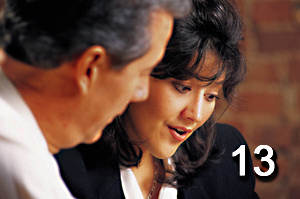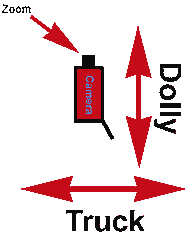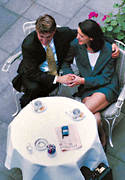|
Film, Radio and TV - 13 |
 Film Script Terminology The best way to learn about screenplays is to read a variety of film scripts. But, before you can understand everything you read, you need to know about basic script terminology. Most of the following applies to both film scripts and television scripts. The basic transitions from one scene to another are:
Traditionally, screenplays (dramatic film scripts) start with fade in and close with fade out. Fade-ins and fade-outs within the production can signal a major change or division within the story structure, such as a passage of time. An insert shot is a closeup of something within the scene. For example, after a man looks at his watch, you might see a cut to closeup of the watch where you can clearly see the time. A cutaway is a related shot that is "away" from the basic scene. For example, during a basketball game you might "cut away" from the action on the floor to a shot of a fan in the stands eating a hot dog. |
|
Script Terms and Abbreviations Although scriptwriters sometimes feel an urge to indicate camera shots and angles on a script, as we've previously suggested, this is an area that's best left to the judgment of the director. Even so, in dramatic scripts you will often see the terms
camera finds indicate the camera moves in on a When the entire camera is moved toward or away from the subject, it's referred to as a dolly. A zoom, which is an optical version of a dolly, achieves somewhat the same effect. Even so, many Directors of Photography feel that compared to a dolly, a zoom is somewhat artificial looking. To indicate either one, a script notation might say, "camera zooms in for closeup of John," or "camera zooms out to show that John is not alone." When a lateral move is needed, the term is truck (note the illustration above). In film, both the dolly and truck movement are often referred to as tracking shots. Sometimes you also see the term moving shot to indicate that the camera moves in some way during the course of a scene Shot designations for films include: Long shot (LS) or full shot (FS). With people, this is a shot from the top of their heads to at least their feet. (To save space we've used a vertical rather than a horizontal format for this photo.) A medium shot (MS) is normally a shot from the waist up. A medium closeup (MCU) is a shot cropped between the shoulders and the belt line. A closeup (CU) is the most desirable to catch changing facial expressions, which are important to following a conversation. Extreme closeups (XCUs) are reserved for dramatic impact. The XCU shot may show just the eyes of an individual. All of these designations can also apply to objects, as in "closeup of toaster shows toast popping up." A boom shot, jib shot, or crane shot refer to high-angle shots, sometimes with the camera moving. An establishing shot is a wide shot (WS) or a long shot (LS). This type of shot gives an audience a basic orientation to the geography of a scene--who is where--after which there should be cuts to closer shots. Thereafter, establishing shots can be momentarily used as reminders or updates on scene changes--where people have moved in relation to each other, etc. In this context they are called reestablishing shots. A master shot is similar to an establishing shot, but this term is generally reserved for the special needs of film. Once the master shot action is filmed, the scene is generally shot over again from different camera positions so that there are shots (especially closeups) of each actor. Dialogue and actor reactions are repeated each time the camera is repositioned. These scenes are referred to as coverage. Often, numerous takes (filmed sequences from the different camera positions in the coverage) are required before a director is satisfied. During editing, all of the film footage will be assembled to make it appear that there is a continuous flow of action. To do this the editor must smoothly cut together the footage from the numerous takes. Actors must repeat everything over again in exactly the same way for each take in the coverage. This means they must use the same energy level with the same actions at the exact points in their dialogue. This is essential in being able to later unobtrusively cut together the various takes during editing to create a smooth, unbroken flow of action. A two-shot or three-shot (also 2-S and 3-S) designates a shot of two or three people in one scene. The term subjective shot
indicates that the audience (camera) will see what the character sees.
Often it indicates a handheld camera shot that moves in a walking
or running motion while following a Camera angles are also sometimes indicated
on scripts. Included are bird's eye view, high angle (photo on left),
eye-level, and low angle shots. A canted shot or a Dutch angle shot (on the right) is tilted 25 to 45 degrees to one side, causing horizontal lines be at an angle. In addition to these basic script terms, there are a number of other abbreviations used in script writing.
So that you can see how some of these things come together, here are some sample scripts.
Typical feature film scripts (note page from dramatic film/video script format above) runs from 100 to 120 pages, which means that each page averages one minute of screen time. A wide variety of In addition, you will find word processing programs to aid in the formatting of scripts on the Internet at In the next module we'll look at "Plotting A Career In Film." |
|
To next module To
index © 1996 - 2005, All Rights Reserved.
|
 particular portion of a scene; camera goes with to indicate
the camera moves with a person or object; reverse angle to
indicate a near 180-degree shift in camera position; and shot widens
to signal a zoom or dolly back.
particular portion of a scene; camera goes with to indicate
the camera moves with a person or object; reverse angle to
indicate a near 180-degree shift in camera position; and shot widens
to signal a zoom or dolly back.
 character. Subjective camera shots can add drama and frenzy to chase
scenes.
character. Subjective camera shots can add drama and frenzy to chase
scenes.